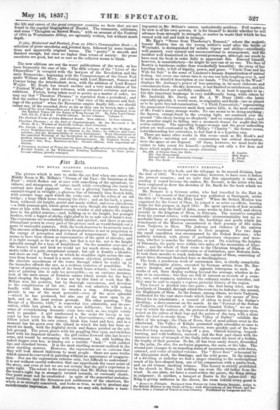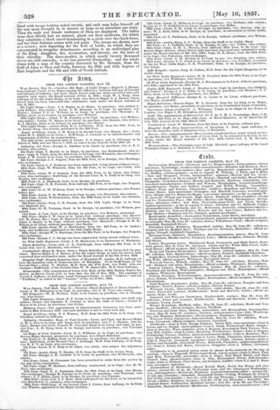Put Arts, THE ROYAL ACADEMY EXHIBITION. THIRD series.
The picture which is sure to strike the eye first when one enters the Middle Room is Mr. Millais's "Dream of the Past—Sir Imams at the Ford" ; which flashes out at once with something of the splendour, vividness, and strangeness, of nature itself, while everything else turns by contrast into dead pigment. One sees a glowing luminous horizon, emerald-tinged in twilight; a glorious line of intensely blue Scotch hills, with autumn trees amid which the rooks caw, and the relics of an old bridge ; a huge black horse crossing the river ; and on his back, a queer, keen, withered old knight, genial and manly withal, and even chivalrous, —a little peasant-girl, whose great open eyes, though she hardly dares to stare at him with them, cannot enough wonder at and admire the mighty hero in his gilded armour,—and, holding on to the knight, her younger brother, with a faggot of sticks, right glad to be so safe out of harm's way. The expressions are wonderfully lifelike and spirited; and there is an easy Viumphant power in every part of the picture such as would furnish out a score of successful painters. Still, the work deserves to be severely taxed. The amount of thought which goes to its production is not in proportion to the energy of perception and richness of temperament : the incident seems to have been chosen as representative of the spirit of chivalry, and it is right enough as far as it goes ; but that is not far, nor is the knight splendid enough for a type of knighthood. On the manifest over-size of the horse's head and neck we would not lay much stress—indeed, the motto talks of a quite eXceptional animal; but call it frankly a blunder, and there an end. The way in which he straddles right across the canvass from bound to bound is a more serious objection pictorially ; and the absolute smoothness of the water through which he wades up to the haunches offends the eye, as a reckless violation of possibility. To vigour of painting every touch of the brush bears witness ; but carelessness of painting also is only too perceptibk,—as an extreme instance, look at the mere smear of formless umber which stands for the boy's hand clasping the knight. It was not by this kind of work that Mr. Millais won his position, but by thorough earnestness, and devotion to the completeness of his art ; and his real admirers will reckon hardly with him whenever he recedes a step. Altogether, this picture is one of the most powerful—even of the most splendid —which he has produced, but also one of the most open to attack, and on the most serious grounds. His other painting, "The Escape of a Heretic, 1569," is somewhat less admirable, and its execution, while less grand, is no whit more deliberate ; but there is a sense of overwhelming dramatic crisis here such as one might vainly seek to parallel. A girl condemned to the stake for heresy is rescued by her lover in the disguise of a friar-confessor,—who gags his fellow priest with his own rosary, binds him hand and foot, and in a moment has his gown over the tabard in which the lady has been arrayed for death, with the frightful devils and flames painted on the yellow ground. The priest glares with his goggling blue eyes, and twitches hard with his impotent thumbs ; the girl rushes forward into her lover's arms, and would be screaming with excitement ; he, still holding the naked dagger over her, is hissing out a terrible "hush ! " with outahot lips and clenched brows. It is the most startling moment realized in the most startling manner. However, the expressions are so extreme that they will look almost ladicrous to most people : there are some truths which cannot be conveyed in painting without an appearance of exaggeration. Nor are the expressions extreme only, but difficult to understand : it is not without careful reflection that one apprehends the exact point of the story, and even at last we are not certain that the girl's expression is qtute right. The colour is the most neutral that Mr. Millais has painted : the lover's right leg is strangely twisted inwards, or curiously elastic. One.pcant must not be overlooked : in spite of the somewhat melodramatic incident, and the fierceness and suddenness of the emotions, the whole is so strongly conceived, and looks so true, as not to produce any Melodramatie impression. Both pictures, we may add, indicate a turn
BERNATI'S ETHIOPIA.•
The preface to this book, and the titlepage to its second division, bear the date of 1852. We do not remember, however, to have seen it before the present occasion ; and we infer that this opportunity is taken of sending it round because the author, Mr. Beings, is the artist who has been employed to draw the sketches of Dr. Barth for the book which we review this week.
Mr. Bornatz is a German artist, who had travelled in the East in l836.'7; his record of that journey was published at Stuttgardt, udder the title of "Scenes in the Holy Land." When the British Mission was organized for the Court of Shoo, he joined it as artist ex-officio, leaving India for this purpose in April 1841. He spent upwards of four months
at Tadjurra near the Gulf of .Aden, some weeks in Aden itself, and eleven
months in the kingdom of Shoe, in Ethiopia. The narrative compiled from his journal relates, with considerable circumstantiality but no re markable force or picturesqueness, the hardships and perils which his detachment of the Mission encountered in their journey of 324 miles from Tadjurra to Shoe. The jealousy and violence of the natives raised up continual interruptions to their progress. For two days the small expedition was encompassed by the Gobad Bedouins; who publicly debated, with plenty of parliamentary eloquence and deco rum, whether to murder the intruders, or not. On reaching the heights of Dinoinala, the party were within two miles of the mountains of Abyssinia; and the whole of their route to the Christian kingdom of Shoe had exhibited no trace of cultivation or of habitation, save Bedouin huts. It took three months to reach Ankobar the capital of Shea, consisting of about three thousand thatched huts or dwellingplaces. The book, a ponderous work of uncommon size, is chiefly remarkable for its lithographic plates, executed by German artists from Mr. Bar natz's designs, and explained by apposite letterpress to each. As works of art, these display nothing beyond the average, whether in design or in execution ; but they arc full of interest as records of a country, race, and manners, unknown to the ordinary reader or traveller, and they may be said to supply a copious pictorial history of tho region. This record is divided into two parts ; the first being Aden, and the Lowlands of Danakil, through which the route lay to .Ankobar; the second, the Highlands of Shea. In the former, among others, we have Tadjurra, celebrated for the vast slave-trade which forms the only means of livelihood for its inhabitants ; a council of elders in front of the Sultan's dwelling; a slave-caravan on the march. In the "Portrait of the Sultan of Tadjurra, and Costumes of the various Danakil Tribes,." we see the way in which the natives sit, the picture of discomfort to European eyes, poised on the calves of their legs and the points of the toes, with a stone under the heel to steady them. "The Valley of Dullul" exhibits the
effect of the mirage ; the Plain of Errer, that of sand-pillars erect in the whirlwind. The Valley of Kilian presented eight crocodiles at once to the eyes of the travellers ; who, however, were quickly quit of the fourteen-feet-long monsters by firing off a gun. Ostrich-hunting, leopardhunting, and wild buffaloes, succeed ; and the first part closes with the maniacal dance of triumph of the Galls, tribe round the head of a buffalo, the trophy of their prowess. So far, all has been sandy desert, diversified by the palm, the aloe, the aselepias gigantea, the oasis, or the lake. The second part changes to an imposing series of mountain-scenes, with forest, cataract, and crater of extinct volcano. The "River Ron" is haunted by the Abyssinian stork, the flamingo, and the wild goose. In the interior of a dwelling at Ankobar we find a singer chanting to the undisciplined touch of his lyre-shaped harp, one of his companions with a psalm-book, and an old woman smoking tobacco. This luxury is strictly prohibited by the church in Shoe ; but nothing can wean the old ladies from the weed. In one plate, we have a court within the palace, the King sitting in judgment; in another, a banquet at Easter in the palace-hall : the King is giving audience in the alcove, the room behind every guest is lined with troops holding naked swords, and each man helps himself off the raw meat brought in in masses as large as an attendant can carry. Then the male and female costumes of Shea are displayed. The ladies wear their frizzly hair an naturel, pluck out their eyebrows, for which they substitute a black curve -terminating in a circle over the cheek-bone, and bar their features across with red paint. The troops are shown, now at a review; now departing for the field of battle, on which they are concentrated in irregular detachments according to an undivulged plan of the King : slaughter, fire, devdstation, and slavery, are the laws of their chivalry. The slave-market, in which nearly twenty thousand slaves are sold annually, is the last pictorial illustration ; and the whole closes with a map of the country traversed by Mr. Bematz, from the Gulf of Aden to Shea and Galla, between the 39th and 45th degrees of East longitude and the 8th and 13th of North latitude.



























 Previous page
Previous page